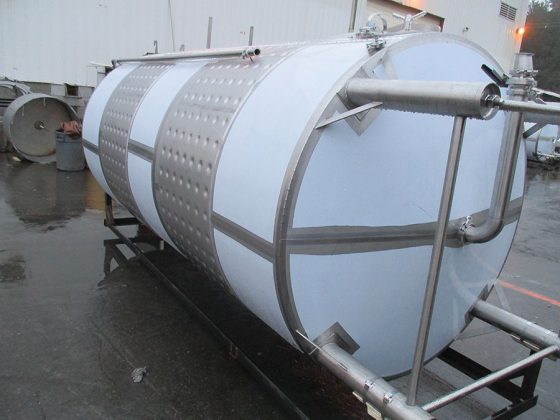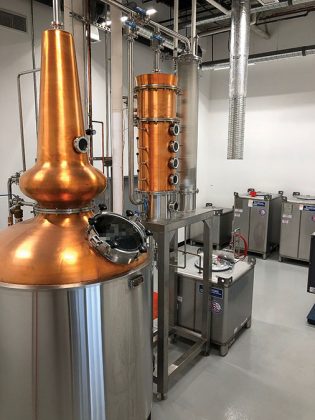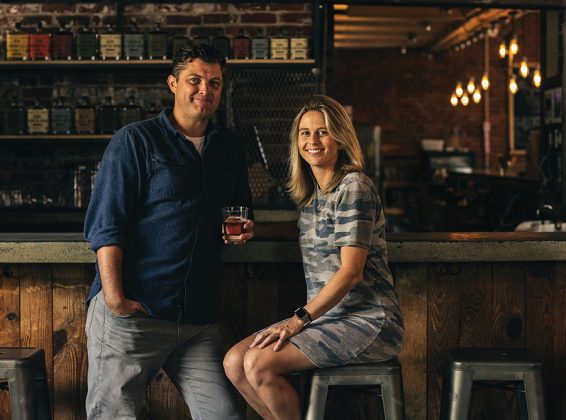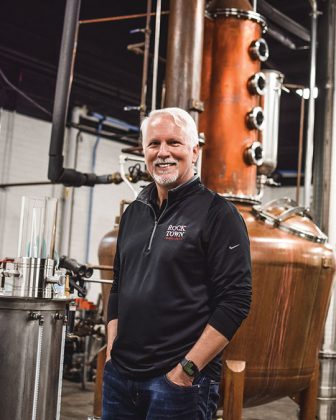When the Craft Beverage Modernization and Tax Reform Act was initially passed at the end of 2017 (with an effective date of January 1, 2018), it marked both the culmination of years of effort and also the beginning of a yet another push. The initial CBMTRA was passed as part of the 2017 Tax Cut and Jobs Act and lowered federal excise taxes from $13.50 to $2.70 for the first 100,000 proof gallons removed from bond annually. However, this change was enacted only for two years, leaving the industry in a state of fragility, if not paralysis.
Sure, the savings are great today, but if those savings turn into a 400% tax increase upon expiration, then there’s not much benefit at all. Any savings would be funneled straight back into the government’s well-lined coffers. “You sell a product that could see an 80% increase in its cost to produce, but you don’t know if that increase is going to happen,” says Phil Brandon, founder of Rock Town Distillery. “How do you plan on what you can do with that uncertainty? Short answer: It’s impossible.”
Tireless efforts from distilleries across the industry helped to create the type of broad bipartisan support rarely seen in Congress — some Congressmen might enjoy whiskey and some might favor gin, but supporting jobs is perhaps more universal — leading first to a one-year extension for 2020, and finally, a permanent enacting of the legislation kicking into gear for 2021 and beyond.
While the benefits of permanent FET reduction seem straightforward enough to grasp, real-world examples are the best way to illustrate what it actually means. Distilleries aren’t walking spreadsheets with numbers in place of faces; they’re small businesses looking to turn a legislative victory into tangible gains for their operations. And it didn’t take long for the impact of permanent FET reduction to be seen at distilleries across the country.
FET Reduction in the Real World
It was fewer than two weeks into the calendar year when Catoctin Creek Distilling announced a $1 million production upgrade. The timing seemed conspicuous, to say the least. “The FET reduction and our announcement on expansion were absolutely related,” says co-founder Scott Harris. “Although we didn’t gather all the funds to fund our expansion from FET savings alone, having the FET reduction gave us the confidence knowing that we’d be financially in a much friendlier environment for selling whiskey than with the higher FETs. If the FET reduction had been rolled back, we would have been in ‘hunker down’ mode again.”
The distillery is planning to triple its production capacity with the purchase of a 2,000-liter copper pot still, along with the necessary mashing and fermentation gear to support it — not to mention the full-time production employees to keep everything churning along. “I know for many of the smallest craft distilleries in the industry, the FET reduction was a matter of survival or going out of business,” Harris says. “We operated successfully before FET was reduced, so we felt we could survive if it had been raised again. But having the lower rates has certainly made our business more efficient.”
When I visited Brandon at Rock Town in the fall of 2020, he spoke at length about the looming uncertainty and his inability to make the types of investments he would otherwise push forward. It’s a different story today, as you might imagine. “Now with the permanent FET reduction, we’ve purchased a new bottling system, we’re looking at expanding distillation capacity, adding salespeople and doing maintenance on our building,” he says.
These are cases in point for why the passage of CBMTRA always made so much sense. It directly helps thousands of small businesses, which in turn benefits tens of thousands of employees as well as the various suppliers, vendors and partners each distillery works with.
“For Yellow Rose Distilling Company, the passage of CBMTRA meant that we could continue our progress to incrementally improve and upgrade the distillery,” says Michael Langan, the head of the distillery. “This year that is taking the form of a new forklift as well as replacing our old boiler with a larger and more efficient one.” Those efforts are alongside a transition from part-time to full-time employees and the beginning of an assistant distiller training program.
Planning, Projecting, Investing
Elsewhere, there’s any number of different ways that a given distillery might benefit from the cost savings associated with CBMTRA. What is consistent across the board is that it allows for solid planning and projecting, without which any business is just shutting their eyes and hoping for the best.
“Until the FET reduction was made permanent, it was nearly impossible for us to effectively plan for major projects and expenses,” says Bob Gunter, president of Kōloa Rum Company. “Once permanent, we were able to confidently execute on several major initiatives, including moving forward with our new distillery expansion project, purchase new equipment to gain increased production capacity and operational efficiencies, and hire additional employees to support our continuing growth.”
At Hotel Tango Distillery, founder Travis Barnes says that permanent FET relief “completely changes” the distillery’s budgeting. “The FET reduction will be hundreds of thousands of dollars for Hotel Tango over the next couple years,” he says. “These savings will allow us to invest in new employees, equipment and marketing to continue growing the company. The savings are quite significant for a growing business, especially in the spirits industry.”
Another area in which FET reduction has paid dividends is the often complex world of financing and loans. “As long as you want to grow, you have to stay in a position where banks are willing to finance your growth,” says Jeff Quint, the founder of Cedar Ridge Distillery. “Had the CBMTRA not been enacted, we would have had to throw our growth plan out the window. When all your free cash flow is being turned over to the federal government in the form of excise taxes, you quickly lose your banker’s interest in extending more financing. Had CBMTRA not happened and the reduced excise tax rate not been extended, we would have a very different future.”
Instead, Cedar Ridge has moved ahead with the addition of a ninth building, along with an investment of $500,000 into new production equipment as well as the hiring of several new employees. “We would have had to match our annual production volume to our current sales rates, eliminating any possibility for growth,” he says. “This would have triggered layoffs, not just in production but also in sales since we would not be expanding our sales reach. This would have changed our company culture and employee morale in a big way. Some of us would have found a way to survive and many wouldn’t have survived.”
In another case, with Barrow’s Intense Ginger Liqueur, founder Josh Morton said the temporary FET reduction led directly to surviving the first year of the pandemic, and now being in a position to utilize that permanent gain. “In 2019, the temporary reduction enabled me to get to profitability which then made me eligible for loans which then kept me in business through the COVID slowdown,” he says. “The permanent reduction will help me to stay in business and pay down those loans.”
Even as the producer of a liqueur — with half the alcohol in the product, there’s half the savings versus a spirit on a per bottle basis — FET is a sizable gain. “The FET was approximately a $40k benefit annually pre-COVID, and while I’m not sure what the impact will be this year, we should get back to at least that in 2022.”
What’s Next?
The craft distilling industry in the US was clearly knocked down, hard, as a result of the pandemic. However, the benefits of having CBMTRA in place permanently will help it stand up once again.
“The effects of the pandemic were debilitating and wreaked havoc on our business this past year,” Gunter says. “Fortunately, the FET reduction served as a partial offset that helped measurably in our efforts to manage and survive the significant loss of revenues from a shrinking economy.”
The crisis has also provided valuable insight across other fronts. “It was an incredibly hard year, while at the same time very satisfying to know we’re still here and ready to face a new day,” Brandon says. “As an industry, we showed that together we can achieve what alone we could not, and that’s very powerful when you think about it.”
The production of hand sanitizer en masse buoyed the position of many distilleries within their local communities. Even when that came with a loss, the long-term upside of increased sales in the future, and legislatively, having more constituents eager to take up your cause with representatives, is a win-win. “When Whiskey Del Bac pivoted to making hand sanitizer, we ended up donating 95% of what we made, so it wasn’t a revenue stream for us, but actually a revenue drain,” says founder Stephen Paul. “However, the goodwill it generated in our community was heartwarming and probably benefitted us in the long run. Likewise, our insistence on being more cautious than our governor on the COVID front was appreciated locally.”
While permanent FET relief is a massive win, and one worthy of celebration, it’s not a panacea for the industry. There are plenty of other pressing issues to tackle, and if you take a survey of distillers, one tends to stand above the rest. “The major issue going forward is direct-to-consumer shipping for distilleries,” Brandon says. “We need to be on par with wineries and allow our guests to get our products wherever they live, not just where we have distribution.”
There has been some momentum there as a result of the pandemic, with various states allowing DTC or the shipment of spirits via third-party vendors. Broader support on a national level would be even better. “The largest issue is with DTC, and the randomness of various state regulations,” says David Brandt, the owner and head distiller of Sespe Creek Distillery. “I believe regulating e-commerce should be done at the federal level, since products are crossing many state lines during shipping. I would love to see the ability to store and ship products from centralized locations in each state. Amazon is ideally structured to support this strategy.”
The intricacies of federal versus state legislation, third-party vendors and the potential for massive corporate logistical support systems are perhaps debates best left for another day. Nevertheless, with a juicy red X crossing off federal excise tax relief from the to-do list, it’s clear that DTC has been circled as the next pressing item.















